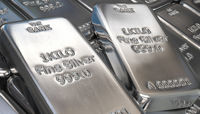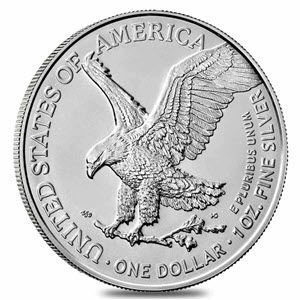Posted on March 31, 2022

Owning silver bullion can come in two forms: allocated silver bullion and unallocated silver bullion. Though the differences between the two sometimes go unknown, each of these silver investments possesses unique qualities that attract – or deter – different investors.
Before we address the different types of ownership of silver bullion, it is important to understand a simple definition of silver bullion. Broadly speaking, silver bullion is a physical metal made up of high-purity silver, which comes in the form of coins, bars, and rounds.
 “Bullion” is distinguished from other types of silver like collectible coins, jewelry, silverware, and so on by one simple characteristic: silver bullion’s value is based on the weight of precious metal, not by aesthetics or rarity, or similar considerations. If you want to know how much silver bullion is worth, just weigh it!
“Bullion” is distinguished from other types of silver like collectible coins, jewelry, silverware, and so on by one simple characteristic: silver bullion’s value is based on the weight of precious metal, not by aesthetics or rarity, or similar considerations. If you want to know how much silver bullion is worth, just weigh it!
Silver bullion coins are nearly pure (at least 0.999 fine) silver, are made by government mints and carry a face value. One example of a silver coin is the American silver eagle coin. Bars can be made by non-government mints or refiners and are pieces of silver that typically come in the shape of an ingot or rectangle in weights ranging from 1 oz to 1,000 oz. Silver rounds are disc-shaped bullion produced by non-government, private mints, and refiners without a face value.
Investors can own silver in a multitude of ways, from coin collections stashed away at home to mining stocks, ETFs tied to silver, and even precious metals IRAs invested in silver bullion. Every type of silver bullion investment comes with its own set of pros and cons, which should always serve as a reminder that not all physical silver ownership options are the same.
For example, “paper silver” investments like mining stocks or ETFs simply aren’t the same as owning physical silver. Each comes with a variety of risks completely unrelated to silver price (too many to get into here). For the rest of this article, we’ll focus on ownership of physical silver bullion.
One common method for investing in physical silver is storing it at a precious metals depository or bullion vault. There are two types of silver storage within a depository: allocated and unallocated.
Allocated silver bullion is silver bullion that is kept discretely (individual and separate from other investors’ silver) in a depository or vault, labeled with the investor’s name on it. Allocated bullion is basically like your very own safe deposit box at a super-high-security bank that specializes in safeguarding high-value assets.
Suppose an investor chooses to sign up with a precious metals depository or other institution’s allocated silver bullion storage. In that case, the institution is responsible for keeping the exact silver the investor deposited on hand, safe and secure, constantly monitored and protected. If an investor wants to withdraw their allocated bullion, the institution holding it must return the specific items that the investor deposited.
The primary benefit of allocated silver bullion is that the investor has complete control not only over their exact silver coins and bars but also how to manage their silver bullion investment. With allocated silver bullion, you know exactly what you own and can choose to move it or sell it at any time. Investors who opt for allocated silver bullion can keep their silver at home, in a safe deposit box, or at an institution’s vault; rest assured that their silver will always be there.
While investors may enjoy having agency over their silver bullion, they also have the responsibility to store and insure that silver. Though the investor may enjoy maintaining possession of the silver, it also means the investor is the one charged with the duty of protecting the silver from damage, loss, or theft. Alternatively, owners of silver bullion can pay someone else to store and insure their silver, which is wise but can chip away at investors’ potential profits. Insurance is a must.
As the most affordable of the precious metals by far, a relatively modest investment in silver bullion can quickly grow to require a relatively large space. Compared to gold, platinum, and palladium, the value-to-size ratio of silver is low, which can drive up the costs of everything from shipping to storage.
Investors in allocated silver may also run into higher costs for storing segregated silver since banks prefer being able to use the physical silver to their own benefit. In addition, while banks may enjoy the savings of bulk pricing on insurance, individual investors will likely be left with higher insurance premiums to pay.
Examples
A common example of allocated bullion is any form of silver bullion (like coins, rounds, and/or bars) kept in a home safe in the investor’s residence. Many investors own allocated silver bullion, which is kept in segregated storage at a precious metals depository or a bullion bank.
Other investors in physical silver bullion may rent a safe deposit box at a bank or credit union, where silver can be stored in a high-security facility with theft deterrents in place. However, you can’t expect to store thousands of dollars worth of silver bullion in a bank’s safe deposit box – you’ll run out of space before you run out of silver.
Unallocated silver bullion is silver bullion pooled with other investors’ silver. With unallocated silver bullion, investors give their bullion to a depository or vault to store, and their account is credited with that same quantity of silver. Pooled bullion is treated as “fungible,” meaning any 1 oz of silver deposited is treated exactly the same as any other 1 oz of silver. Investors who choose unallocated storage should not expect to receive the original silver they deposited but the same weight of silver, presumably of equal value.
When an investor buys or deposits unallocated silver bullion, that individual is entitled to the weight of the silver they deposited. However, they may never see the exact items they originally owned. In other words, the weight of the silver is retained, but the specific coins or bars the investor buys are commingled with the unallocated silver of other investors.
Yes, we’re belaboring this point, but it’s important: unallocated bullion is, quite simply, not the same as owning physical silver. Rather, it’s a claim on some quantity of silver, an IOU issued by a bank to the investor. Unallocated bullion is the property of the bank, not the investor.
And, because it’s bank property, the bank may use unallocated bullion to issue loans, sell to other institutions or banks, fund other account owners’ withdrawals, basically whatever they want.
Unallocated silver bullion is a popular way to invest in silver because it is, generally speaking, the more affordable way to gain some investment exposure to silver. When the bank retains physical control of investors’ silver, it can use that silver to conduct its business and turn a profit in any way they want.
Since unallocated silver is unsegregated from other silver, the bank can trade it freely and store it anywhere, reducing its own costs and sharing those lower prices with investors. Banks also hold a substantial amount of bullion, giving them access to cheaper storage and insurance, which helps offset overall costs for investors.
Lower storage pricing can make unallocated silver bullion an attractive investment, but these savings are accompanied by some risks and drawbacks. An investment in unallocated silver means that if you withdraw your silver, you likely will not be given the same silver you deposited but a very similar product.
If you own a large quantity of silver, the institution holding your unallocated bullion may not even keep enough silver to give you the entire amount without advance notice. (Have you ever gone to the bank to withdraw money, and they said they couldn’t give you that much? Yeah, like that.)
Though it is unlikely, it is possible that the physical bullion you withdraw could be counterfeit, or simply less desirable than the silver you initially deposited.
Since unallocated silver is not held in possession directly by the investor, there is also the rare, though potentially devastating, risk of bank failure. As an unsecured creditor, owners of unallocated silver bullion do have to live with the slim chance of complete investment loss if the bank backing the silver fails and cannot pay its debts. There’s no FDIC coverage for your “paper silver” account with the bank.
Overall, unallocated silver will incur lower storage fees for the investor since the bank can just add the silver to a central pool rather than reserve a dedicated space for that single investor. Also, the bank charges lower fees because they’re using your silver for their profit!
Examples of unallocated, “paper silver” may include ETFs and other funds tied to silver’s performance, unallocated silver accounts at a bank, or physical silver kept in unsegregated storage. With unallocated silver, account owners are essentially investing physical silver with a bank in exchange for the bank’s promise to give them back a like amount of silver.
|
Allocated Silver Bullion |
Unallocated Silver Bullion |
|---|---|
|
You keep the exact silver you deposit |
Unallocated silver is the most popular, affordable way to invest in silver |
|
Allocated silver bullion is the best way to make a direct investment in physical silver |
The institution or bank may not keep the entire amount of your silver investment in storage |
|
Risk of theft, damage, or loss |
You depend on the bank or depository to keep your bullion safe |
|
Unless the silver is lost, stolen, or destroyed, it will always be there; investors can move or sell at any time, for any reason |
When you make a withdrawal, you aren't likely to get back the exact silver you deposited |
|
Allocated silver will not be affected by a business's performance or bank failure |
Bank failure or poor bank performance could result in investor losses |
|
Allocated silver usually comes with higher costs since it requires a dedicated storage space |
|